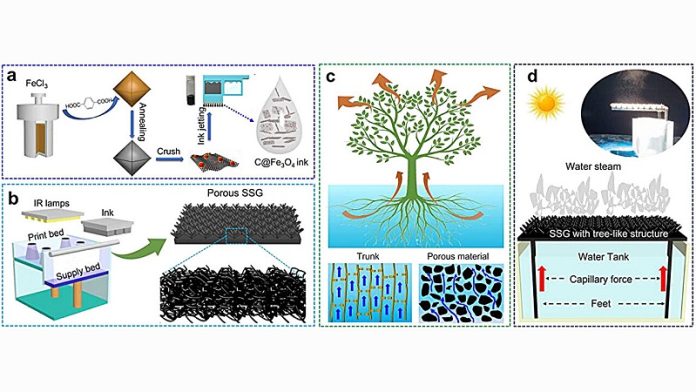
To tackle the global challenge of freshwater scarcity, researchers in Singapore have developed a new type of solar steam generator (SSG) that uses the sun’s energy to desalinate seawater.
Desalination, while essential for providing fresh water, is usually expensive and energy-intensive.
The new SSGs offer a more sustainable and cost-effective solution.
These innovative SSGs, inspired by the natural water cycle, use solar energy to evaporate water. However, traditional SSGs require complex designs to increase the surface area for better water evaporation.
To address this, the research team turned to 3D printing and took inspiration from trees to create more efficient SSGs.
In a paper published in Applied Physics Reviews, the team presented their advanced technology for making effective SSGs and introduced a new method for printing functional nanocomposites using multi-jet fusion (MJF).
Professor Kun Zhou from Nanyang Technological University explained, “We created SSGs with excellent photothermal performance and self-cleaning properties.
The treelike porous structure significantly improves water evaporation rates and prevents salt buildup, ensuring stable performance even after long use.”
The SSGs work by converting sunlight into heat, which then evaporates the water. The porous structure of the SSGs helps remove accumulated salt, ensuring continuous desalination performance.
The team used a special photothermal fusing agent and MJF printing technology to quickly create parts with intricate designs. They developed a new type of fusing agent from metal-organic frameworks to enhance the photothermal conversion efficiency.
The SSGs, inspired by plant transpiration, consist of miniature tree-shaped microstructures that form an efficient, heat-distributing network. This design increases the surface area, enhancing water transport and evaporation efficiency.
“Our bio-inspired design increases the surface area of the SSG,” said Zhou. “Using a treelike design boosts evaporation efficiency and improves water transport.”
One notable finding was the high rate of water evaporation observed in both lab tests and real-world trials. The desalinated water consistently met drinking water standards, even after prolonged use.
“This shows the practicality and efficiency of our approach,” Zhou said. “And it can be mass-produced quickly and easily using MJF commercial printers.”
The researchers believe their SSGs have great potential for addressing freshwater scarcity. “Our SSGs can provide a sustainable and efficient desalination solution in regions with limited access to freshwater,” said Zhou. “Beyond desalination, they can be adapted for other applications requiring efficient solar energy conversion and water purification.”
This new technology offers hope for a more sustainable and accessible way to produce fresh water from seawater, helping to alleviate the global water crisis.


